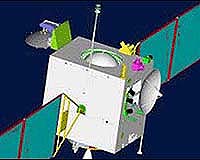 |
Washington DC (SPX) Sep 16, 2010 NASA's Lunar Reconnaissance Orbiter, or LRO, will complete the exploration phase of its mission on Sept. 16, after a number of successes that transformed our understanding of Earth's nearest neighbor. LRO completed a one-year exploration mission in a polar orbit approximately 31 miles above the moon's surface. It produced a comprehensive map of the lunar surface in unprecedented detail; searched for resources and safe landing sites for potential future missions to the moon; and measured lunar temperatures and radiation levels. The mission is turning its attention from exploration objectives to scientific research, as program management moves from NASA's Exploration Systems Mission Directorate to the Science Mission Directorate at the agency's Headquarters in Washington. "LRO has been an outstanding success. The spacecraft has performed brilliantly," said Doug Cooke, associate administrator of the Exploration Systems Mission Directorate. "LRO's science and engineering teams achieved all of the mission's objectives, and the incredible data LRO gathered will provide discoveries about the moon for years to come." The LRO team will continue to send data gathered during the last year to the Planetary Data System, which archives and distributes scientific information from NASA planetary missions, astronomical observations and laboratory measurements. By the time LRO achieves full mission success in March, and its data is processed and released to the scientific community, it will have sent more information to the Planetary Data System than all other previous planetary missions combined. During its new phase of discovery, LRO will continue to map the moon for two to four more years. "The official start of LRO's science phase should write a new and intriguing chapter in lunar research," said Ed Weiler, associate administrator for the Science Mission Directorate. "This mission is one more asset added to NASA's vast science portfolio." The spacecraft launched from NASA's Kennedy Space Center in Florida carrying a suite of seven instruments on June 18, 2009. LRO formally began its detailed survey of the moon in September 2009. Results from the mission include: new observations of the Apollo landing sites; indications that permanently shadowed and nearby regions may harbor water and hydrogen; observations that large areas in the permanently shadowed regions are colder than Pluto; detailed information about lunar terrain; and the first evidence of a globally distributed population of thrust faults that indicates the moon has recently contracted and may still be shrinking. LRO also took high resolution pictures of the Lunokhod 1 rover that had been lost for almost 40 years. The rover, which carries a retroreflector, was located to within approximately 150 feet. The accurate position data enabled researchers on Earth to bounce laser signals off the retroreflector for the first time ever. The retroreflector is providing important new information about the position and motion of the moon. LRO also supported the Lunar Crater Observation and Sensing Satellite impact, a companion mission sent to determine if the moon's poles harbor water ice, by helping to select a promising impact site. LRO observed both the expanding plume that arose after the impact and the evolving temperature at the site.
Share This Article With Planet Earth
Related Links LRO Mars News and Information at MarsDaily.com Lunar Dreams and more
 China preps next lunar space mission
China preps next lunar space missionBeijing (AFP) Sept 10, 2010 China is on track to launch its second lunar satellite by year's end, as the country pursues its plans for a manned mission to the moon by 2020, state media said Friday. Preparations for the launch of the Chang'e-2 probe, which will go into orbit within 15 kilometres (nine miles) of the moon, are going smoothly, People's Daily said, citing Wu Weiren, a senior engineer overseeing the programm ... read more |
|
| The content herein, unless otherwise known to be public domain, are Copyright 1995-2010 - SpaceDaily. AFP and UPI Wire Stories are copyright Agence France-Presse and United Press International. ESA Portal Reports are copyright European Space Agency. All NASA sourced material is public domain. Additional copyrights may apply in whole or part to other bona fide parties. Advertising does not imply endorsement,agreement or approval of any opinions, statements or information provided by SpaceDaily on any Web page published or hosted by SpaceDaily. Privacy Statement |